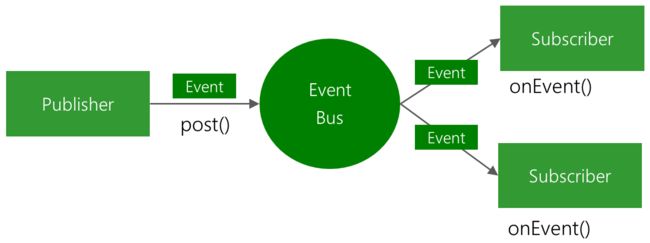EventBus源码理解
EventBus是我们在开发中经常使用的开源库,使用起来比较简单,而且源码看起来不是很吃力。受到广大开发者的喜爱~
综述 !
上面这张图片很好的解释了EventBus工作流程,简单来说就是事件被提交到EventBus之后进行查找所有订阅该事件的方法然后执行这些方法.
获取EventBus实例(单例模式)
使用了双重判断的方式,防止并发的问题,还能极大的提高效率。
public static EventBus getDefault() {
if (defaultInstance == null) {
synchronized (EventBus.class) {
if (defaultInstance == null){
defaultInstance = new EventBus();
}
}
}
return defaultInstance;
}
构造方法
public EventBus() {
this(DEFAULT_BUILDER);
}
注册
public void register(Object subscriber) {
Class subscriberClass = subscriber.getClass();
List subscriberMethods = subscriberMethodFinder.findSubscriberMethods(subscriberClass);
synchronized (this) {
for (SubscriberMethod subscriberMethod : subscriberMethods) {
subscribe(subscriber, subscriberMethod);
}
}
}
这里面其中参数就是订阅者,也就是我们写的this,register方法主要完成两件事,查找订阅者中所有的订阅方法,然后通过遍利订阅着的订阅方法完成订阅操作。我们首先看下findSubscriberMethods这个方法:
//从缓存中获取SubscriberMethod集合
List findSubscriberMethods(Class subscriberClass) {
List subscriberMethods = METHOD_CACHE.get(subscriberClass);
if (subscriberMethods != null) {
return subscriberMethods;
}
//ignoreGeneratedIndex是否忽略注解器生成的MyEventBusIndex
if (ignoreGeneratedIndex) {
subscriberMethods = findUsingReflection(subscriberClass);
} else {
subscriberMethods = findUsingInfo(subscriberClass);
}
if (subscriberMethods.isEmpty()) {
throw new EventBusException("Subscriber " + subscriberClass
+ " and its super classes have no public methods with the @Subscribe annotation");
} else {
METHOD_CACHE.put(subscriberClass, subscriberMethods);
return subscriberMethods;
}
}
SubscriberMethod 这个类中主要是用保存订阅方法的Method对象,线程模式,事件类型,优先级,是否粘性事件等属性,主要是两个方法findUsingReflection(subscriberClass),findUsingInfo(subscriberClass),这两个方法的区别就是有没有配置subscriberInfo
findUsingInfo
private List findUsingInfo(Class subscriberClass) {
//在FindState里面,它保存了一些订阅者的方法以及对订阅方法的校验
FindState findState = prepareFindState();
findState.initForSubscriber(subscriberClass);
// 如果我们通过EventBusBuilder配置了MyEventBusIndex,便会获取到subscriberInfo 通常情况下我们下代码的时候并没有配置~
while (findState.clazz != null) {
findState.subscriberInfo = getSubscriberInfo(findState);
if (findState.subscriberInfo != null) {
SubscriberMethod[] array = findState.subscriberInfo.getSubscriberMethods();
for (SubscriberMethod subscriberMethod : array) {
if (findState.checkAdd(subscriberMethod.method, subscriberMethod.eventType)) {
findState.subscriberMethods.add(subscriberMethod);
}
}
} else {
//通过反射来查找订阅方法
findUsingReflectionInSingleClass(findState);
}
findState.moveToSuperclass();
}
return getMethodsAndRelease(findState);
}
# findUsingReflectionInSingleClass
- 没有通过EventBusBuilder配置MyEventBusIndex的情况下就执行这个方法了
private void findUsingReflectionInSingleClass(FindState findState) {
Method[] methods;
try {
// This is faster than getMethods, especially when subscribers are fat classes like Activities
methods = findState.clazz.getDeclaredMethods();
} catch (Throwable th) {
// Workaround for java.lang.NoClassDefFoundError, see https://github.com/greenrobot/EventBus/issues/149
methods = findState.clazz.getMethods();
findState.skipSuperClasses = true;
}
for (Method method : methods) {
int modifiers = method.getModifiers();
if ((modifiers & Modifier.PUBLIC) != 0 && (modifiers & MODIFIERS_IGNORE) == 0) {
Class[] parameterTypes = method.getParameterTypes();
//定于方法中只能有一个参数
if (parameterTypes.length == 1) {
Subscribe subscribeAnnotation = method.getAnnotation(Subscribe.class);
if (subscribeAnnotation != null) {
//保存到findState对象当中
Class eventType = parameterTypes[0];
if (findState.checkAdd(method, eventType)) {
ThreadMode threadMode = subscribeAnnotation.threadMode();
findState.subscriberMethods.add(new SubscriberMethod(method, eventType, threadMode,
subscribeAnnotation.priority(), subscribeAnnotation.sticky()));
}
}
} else if (strictMethodVerification && method.isAnnotationPresent(Subscribe.class)) {
String methodName = method.getDeclaringClass().getName() + "." + method.getName();
throw new EventBusException("@Subscribe method " + methodName +
"must have exactly 1 parameter but has " + parameterTypes.length);
}
} else if (strictMethodVerification && method.isAnnotationPresent(Subscribe.class)) {
String methodName = method.getDeclaringClass().getName() + "." + method.getName();
throw new EventBusException(methodName +
" is a illegal @Subscribe method: must be public, non-static, and non-abstract");
}
}
}
回到register这个方法中,上面我们分析了寻找订阅着方法部分,接下来就是注册了
subscribe
// Must be called in synchronized block
private void subscribe(Object subscriber, SubscriberMethod subscriberMethod) {
//获取订阅者方法中的订阅事件
Class eventType = subscriberMethod.eventType;
//创建一个Subscription来保存订阅者和订阅方法
Subscription newSubscription = new Subscription(subscriber, subscriberMethod);
//获取当前订阅事件中Subscription的List集合
CopyOnWriteArrayList subscriptions = subscriptionsByEventType.get(eventType);
if (subscriptions == null) {
//该事件对应的Subscription的List集合不存在,则重新创建并保存在subscriptionsByEventType中
subscriptions = new CopyOnWriteArrayList<>();
subscriptionsByEventType.put(eventType, subscriptions);
} else {
//肯定药判断订阅者是否已经被注册啦
if (subscriptions.contains(newSubscription)) {
throw new EventBusException("Subscriber " + subscriber.getClass() + " already registered to event "
+ eventType);
}
}
//将newSubscription按照订阅方法的优先级插入到subscriptions中
int size = subscriptions.size();
for (int i = 0; i <= size; i++) {
if (i == size || subscriberMethod.priority > subscriptions.get(i).subscriberMethod.priority) {
subscriptions.add(i, newSubscription);
break;
}
}
//通过订阅者获取该订阅者所订阅事件的集合
List> subscribedEvents = typesBySubscriber.get(subscriber);
if (subscribedEvents == null) {
subscribedEvents = new ArrayList<>();
typesBySubscriber.put(subscriber, subscribedEvents);
}
//将当前的订阅事件添加到subscribedEvents中
subscribedEvents.add(eventType);
if (subscriberMethod.sticky) {
if (eventInheritance) {
// Existing sticky events of all subclasses of eventType have to be considered.
// Note: Iterating over all events may be inefficient with lots of sticky events,
// thus data structure should be changed to allow a more efficient lookup
// (e.g. an additional map storing sub classes of super classes: Class -> List).
Set, Object>> entries = stickyEvents.entrySet();
for (Map.Entry, Object> entry : entries) {
Class candidateEventType = entry.getKey();
if (eventType.isAssignableFrom(candidateEventType)) {
Object stickyEvent = entry.getValue();
checkPostStickyEventToSubscription(newSubscription, stickyEvent);
}
}
} else {
Object stickyEvent = stickyEvents.get(eventType);
checkPostStickyEventToSubscription(newSubscription, stickyEvent);
}
}
}
这个方法才是真正的注册,上面我们说的知识寻找订阅者订阅事件的方法。概括来说首先会根据subscriber和subscriberMethod来创建一个Subscription集合subscriptions,然后根据事件类型eventType获取事件集合并把他们添加到typesBySubscriber中,然后把Subscription对象添加到subscriptions中。
事件的发送
首先药获取EventBus对象,然后通过Post方法进行事件的发送
public void post(Object event) {
//PostingThreadState保存着事件队列和线程状态信息
PostingThreadState postingState = currentPostingThreadState.get();
//获取事件队列,并将当前事插入到事件队列中
List上面在订阅的时候我们以订阅事件为key,将Subscription的List集合作为Value保存到了一个Map中 ,下面这个方法就是通过key来取出集合
private void postToSubscription(Subscription subscription, Object event, boolean isMainThread) {
switch (subscription.subscriberMethod.threadMode) {
case POSTING:
invokeSubscriber(subscription, event);
break;
case MAIN:
if (isMainThread) {
invokeSubscriber(subscription, event);
} else {
mainThreadPoster.enqueue(subscription, event);
}
break;
case BACKGROUND:
if (isMainThread) {
backgroundPoster.enqueue(subscription, event);
} else {
invokeSubscriber(subscription, event);
}
break;
case ASYNC:
asyncPoster.enqueue(subscription, event);
break;
default:
throw new IllegalStateException("Unknown thread mode: " + subscription.subscriberMethod.threadMode);
}
}
这就是我们在接收信息的时候所用到的几个方法,具体含义就不再啰嗦了。到这里啊管理EventBus所涉及的源码分析的差不多了,虽然还有好多地方没有分析到位,但大体的思路是有的。
